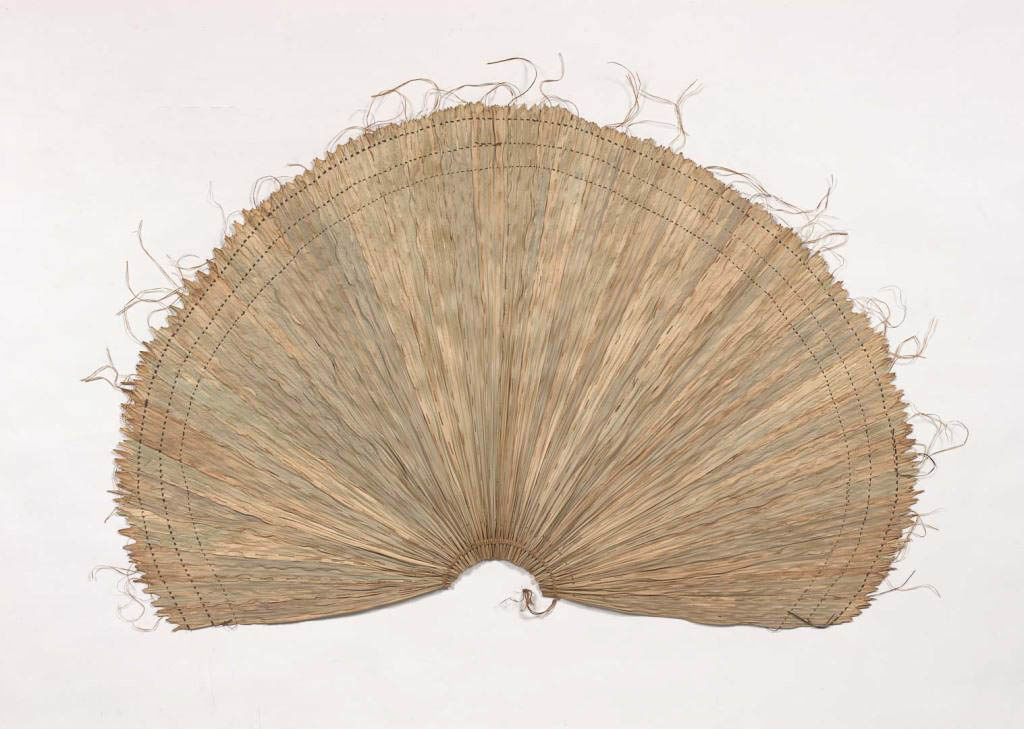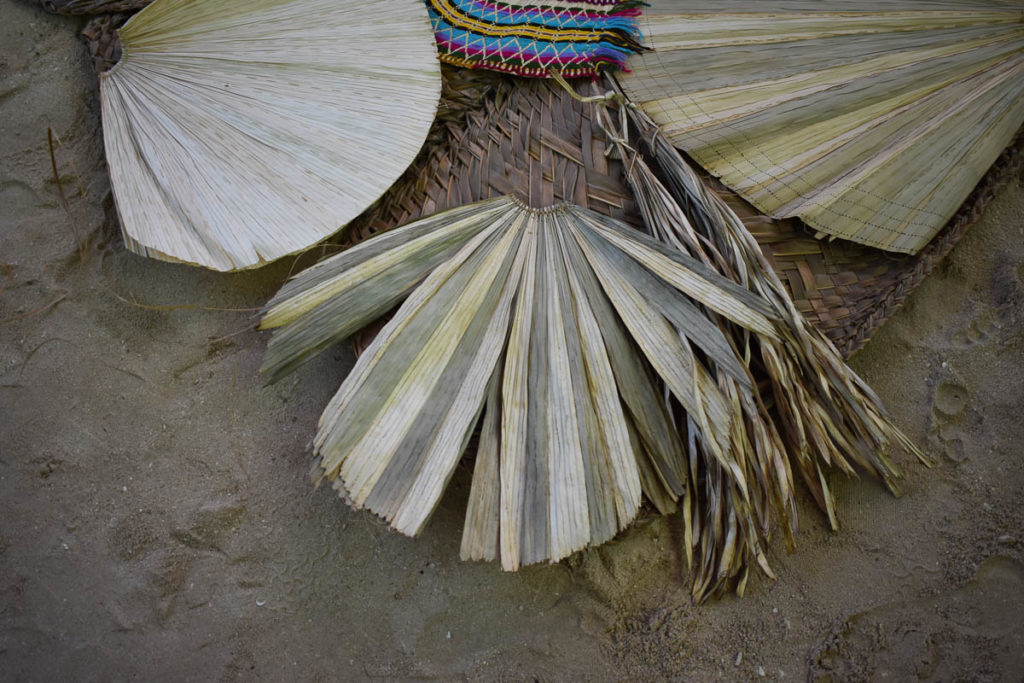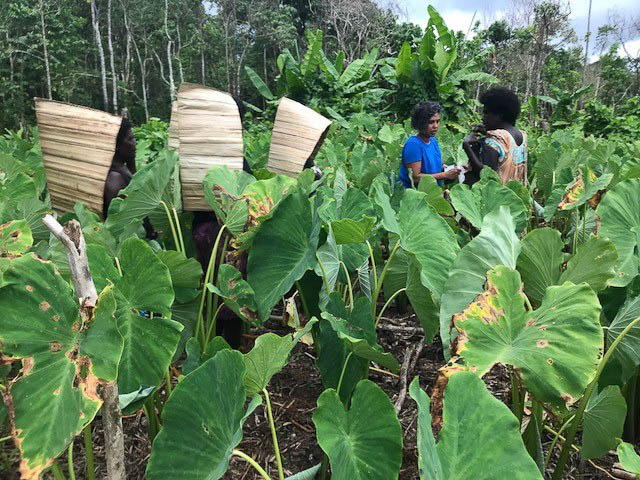- HELEN DUSIMOI MIRIONA / Bakoriku clan, Nasioi language group / AROB b.1966 Biruko – Kaapina (Tanganu) (pathway that separates gardens) design 2018 Biriko, baru (bush vine string), minkitaa (brown dye from noni) Purchased 2018 with funds from the Queensland Art Gallery | Gallery of Modern Art Foundation / Collection: Queensland Art Gallery Image courtesy the artist and Queensland Art Gallery l Gallery of Modern Art Photograph: Natasha Harth
- ADELAIDE MEKEA ANIONA / Barapang clan, Nasioi language group / AROB c.1939 Biruko 2018 Biriko (black palm leaf), wool, baru (bush vine string) Purchased 2018 with funds from the Queensland Art Gallery | Gallery of Modern Art Foundation / Collection: Queensland Art Gallery Image courtesy the artist and Queensland Art Gallery l Gallery of Modern Art Photograph: Natasha Harth
- NAKAS CLAN Hakö language group KIRIA BLANDINA ASIKE LEAD ARTIST AROB b.1959 RACHAEL HAPIOUS HAKOT AROB b.1963 THERESE PITAPITA HAROHI AROB b.1958 LYDIAN TARINE HAVINI AROB b.1994 MARIA LINGI HUGESE AROB b.1951 ELIZABETH NGOSI LAMBERT AROB b.1956 JUDITH PENA AROB b.1968 A’Poa 2018 Pandanus, hakolu (red noni root dye), hakiri (wild banana bark) Purchased 2018 with funds from Professor Susan Street ao through the Queensland Art Gallery | Gallery of Modern Art Foundation / Collection: Queensland Art Gallery Image courtesy the artist and Queensland Art Gallery l Gallery of Modern Art Photograph: Natasha Harth
- KIRIA BLANDINA ASIKE / Nakas clan, Hakö language group / AROB b.1959 Kakoto 2018 Pandanus, hakolu (red noni root dye), hakiri (wild banana bark) Purchased 2018 with funds from Professor Susan Street ao through the Queensland Art Gallery | Gallery of Modern Art Foundation / Collection: Queensland Art Gallery Image courtesy the artist and Queensland Art Gallery l Gallery of Modern Art Photograph: Natasha Harth
- Helen Dusimoi Miriona and Adelaide Mekea Aniona, Biruko, Women’s Wealth Workshop, Nazareth Rehabilitation Centre, Autonomous Region of Bougainville, Sept. 2017. Image courtesy Queensland Art Gallery l Gallery of Modern Art Photograph: Ruth McDougall
- Helen Dusimoi Miriona, Biruko and materials, Women’s Wealth Workshop, Nazareth Rehabilitation Centre, Autonomous Region of Bougainville, Sept. 2017. Image courtesy Taloi Havini and Queensland Art Gallery l Gallery of Modern Art Photograph: Taloi Havini
- Filming of Tuhu hoods for Taloi Havini Habitat 2018, Autonomous Region of Bougainville, October 2018 Image courtesy Taloi Havini and Queensland Art Gallery l Gallery of Modern Art Photograph: Amanda King
- Elizabeth Saman creating Sinsu, Women’s Wealth Workshop, Nazareth Rehabilitation Centre, Autonomous Region of Bougainville, Sept. 2017. Image courtesy Queensland Art Gallery l Gallery of Modern Art Photograph: Ruth McDougall
Women’s Wealth is an art project that engages with the ongoing importance and richness of women’s creativity within the predominantly matrilineal societies of the Autonomous Region of Bougainville and nearby provinces of the Solomon Islands. It focuses on weaving, pottery and body adornment. The works produced for the Asia Pacific Triennial at Queensland Art Gallery arose out of a series of workshops. We share two of the special fibre objects with you.
Biruko and mats
Often created by groups of women, textiles made in the Autonomous Region of Bougainville from the leaves of local plants and dyed with extracts of the roots and seeds are surrounded by story. The designs marked on the surface of textiles or woven into their structure are inspired by patterns observed in the natural world and carry associated attributes. The clan stories associated with these designs are recounted by the women who strip the leaves, grate the roots and weave or stitch the textiles. These artists also tell stories about the objects themselves, tracing the possible pathways that they will travel into the lives of others, or recalling similar textiles that were made and gifted to them personally.
Many of these textiles—from the biruko fans to the more humble pandanus mat—are kept close to the body, used as mats, knapsacks, shelters and for presenting or covering food. Central Bougainville women will often carry or wear a biruko, as a personal adornment, or carry a pandanus mat marked with designs which signify her gender and cultural identity. These objects are frequently exchanged between kin and clan members as an expression of reciprocity, love and attachment. While firmly located in the realm of women’s lives in regard to home, family and the garden, textiles such as biruko and pandanus mats can also be transformed into ritual valuables used in interclan exchanges and ceremonial occasions marking particular rites of passage such a marriage and coming of age. Women will work in groups to create large quantities of textiles, combining them with food from their gardens and store-bought goods to contribute to the gift.
Today, perhaps the most popular use of the biruko is as part of singsing (dance ceremonies) where their unique fan-shaped form and bright patterning enhances the women dancers’ sinuous movements. Despite the biroku being a textile specifically from Central Bougainville, these dances are performed at festivals and cultural days as expressions of identity and cultural connection by women from across all districts of this Autonomous Region and its diaspora.
Acquired for the QAGOMA collection, these works have been created specifically for the Women’s Wealth project in the 9th Asia Pacific Triennial of Contemporary Art. This project engages with the importance of women’s voices in the Autonomous Region of Bougainville. The cultures comprising this region are predominantly matrilineal, with land ownership and chieftainship passing through the female line. This is a locale that has been heavily impacted through a history of colonial occupation, war and mining. As the caretakers of the land, women have been some of the most outspoken opponents to the development of traditional lands undertaken by foreign interests and the maintenance of culture. While receptive to outside goods and systems that improve livelihood, these women continue to create textiles and maintain customs that express their different social values often incorporating new materials and store-bought textiles into their relational transactions. Within these transactions, reciprocity and the importance of networks of relationship are prioritised over ideas of individuality and wealth.
These elegant textiles are not “wealth” in the English parlance, where the word describes ideas of an abundance or accumulated surplus or resources that have a financial value. Rather, they are important because they constitute an individual’s creative effort toward honouring connections to place, culture and people. Precious in their stitching, the textiles are a tangible outcome of work completed over days within a circle of women friends and family which is counter to the forces of alienated labour, mass production and consumerism. These textiles are significant because they creatively maintain relations, values and ideas that keep unique cultures alive in the face of a global modernity.
Tuhu hoods
Elegant hoods constructed from broad pandanus leaves and in some instances marked with bold red and black embroidered designs designating the elevated status of the owner are made by women in the North of Bougainville. Afforded names corresponding with the status of the wearer, these unique sculptural forms are representative of some of the most important forms of visual expression in this region and are worn as a form of ornamentation as well as a protective covering in public ceremonies relating to the coming of age, matrimony, death and the investiture of clan chiefs.
This area of Bougainville is matrilineal with descent traced through the mother’s lineage. This includes the transfer of land ownership and status (chieftain system). Each village will have a Tsuhana (clan house) with three individual posts with each post assigned a chief. The highest-ranking chief of the clan is the Queen who represents the middle post of the Tsuhana and who is protected on both sides by her maternal kin.
A clan Queen will wear a variety of different Tuhu hoods during her life corresponding with the ceremonies that affirm her journey through various significant rites of passage. When she is prepared for bride price, her mother and other high-ranking female relatives will be similarly adorned with two hoods with markings corresponding to their status.
The most ornate tuhu hoods known as A’Pua, cover the wearer from head to foot and are embroidered with all of the clan’s designs. These tuhu can be worn only by the clan Queen for Palmatana ceremonies and as a coffin at death.
Clan women without this status will wear an unmarked hood known as a Tulbus during public life-affirming ceremonies including Gagaskuri (coming of age), betrothal and death. While the ornately decorated tuhu worn in ceremony operate very much like a crown for European royalty, the unmarked Tulbus fulfil multiple functions within and outside of ceremony, being used within everyday life as mats, food covers as well as shelter from the rain and sun.
Each village has clan women known for their knowledge of both the designs and methods for creating the Tuhu who are commissioned to make the hoods for ceremony. Often the higher-ranking North Bougainville clans of Nakaripa and Naboin will commission skilled Nakas women to create their Tuhu. They will, however, own the designs, which the Nakas artists can use only for the designated commission and under their instruction. Strict protocols also surround various stages of the preparation of materials for the decorated hoods and these works subsequently carry great spiritual as well as aesthetic significance.
Ceremonies led by village chiefs and involving the killing and eating of a pig were held in the villages of Ngakulbul and Hangehe to authorise the creation of sacred Tuhu for QAGOMA’s APT9 Women’s Wealth project.
While the maintenance of this chiefly system and its attendant cultural practices remain strong in the Hakö constituencies of North Bougainville, many of the cultural and aesthetic practices once found in this region have been severely impacted through the far-reaching implications of colonialism, the introduction of Christianity, militarism, the labour-trade and the more recent civil war (1988-2001).
Majestically occupying space with both their strong sculptural forms and embroidered designs, the tuhu represent a continued engagement with both the natural environment and an indigenous governing system. As such they constitute a powerful resistance to globalising forces of alienated labour, mechanised production and environmental destruction that have had such a devastating impact on the recent history in Bougainville. In addition to their role as contemporary articulations of this region’s most significant forms of cultural and artistic expression, the Tuhu are statements of cultural resilience and pride.
Edited extracts of text first published in The 9th Asia Pacific Triennial of Contemporary Art, Queensland Art Gallery | Gallery of Modern Art, South Brisbane, 2018. More information about Women’s Wealth here.
Women’s Wealth is supported by the Australian Government through the Australian Cultural Diplomacy Grants Program of the Department of Foreign Affairs and Trade, the Gordon Darling Foundation, the Brisbane Bougainville Community Group Inc., the Cairns Bougainville Association, QUT Creative Industries and Queen Emma Chocolate Company.
The Solomon Islands artists’ participation was supported by QAGOMA’s Oceania Women’s Fund, enabled by the generous bequest of Jennifer Phipps.
Authors
 Born in Buka Island, Bougainville, Papua New Guinea; Sana came to Australia in 1988. With a science degree, Sana was working as a laboratory technician at the Paguna mine when she met her Australian husband, Bryan. Once in Australia, Sana was approached to look after the Melanesian collection at the National Gallery of Victoria. Sana is now assistant curator of Indigenous art at the gallery. An applied science graduate, Sana began her museum career in the Indigenous department at Melbourne Museum from 1997–2002, which led to her employment as Assistant Curator of Indigenous Art at the NGV in 2004.
Born in Buka Island, Bougainville, Papua New Guinea; Sana came to Australia in 1988. With a science degree, Sana was working as a laboratory technician at the Paguna mine when she met her Australian husband, Bryan. Once in Australia, Sana was approached to look after the Melanesian collection at the National Gallery of Victoria. Sana is now assistant curator of Indigenous art at the gallery. An applied science graduate, Sana began her museum career in the Indigenous department at Melbourne Museum from 1997–2002, which led to her employment as Assistant Curator of Indigenous Art at the NGV in 2004.
 Ruth McDougall is the Curator of Pacific Art at the QAGOMA, where she curated the exhibition No 1 Neighbour: Art in Papua New Guinea 1966-2016. Part of the curatorial team for the 9th Asia Pacific Triennial of Contemporary Art, she also curated the exhibition Threads: Contemporary textiles and the Social Fabric (2011), and was part of the Curatorial team for the 8th and 7th Triennials as well. With a Master’s Degree in Visual Arts from Goldsmiths College, University of London, McDougall was a recipient of the inaugural round of Samstag Visual Arts Scholarships (1994) and undertook a Churchill Fellowship in 2013.
Ruth McDougall is the Curator of Pacific Art at the QAGOMA, where she curated the exhibition No 1 Neighbour: Art in Papua New Guinea 1966-2016. Part of the curatorial team for the 9th Asia Pacific Triennial of Contemporary Art, she also curated the exhibition Threads: Contemporary textiles and the Social Fabric (2011), and was part of the Curatorial team for the 8th and 7th Triennials as well. With a Master’s Degree in Visual Arts from Goldsmiths College, University of London, McDougall was a recipient of the inaugural round of Samstag Visual Arts Scholarships (1994) and undertook a Churchill Fellowship in 2013.









